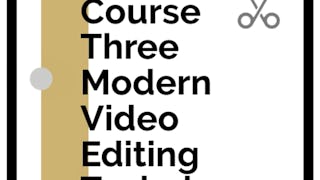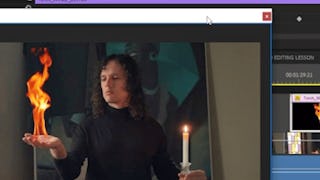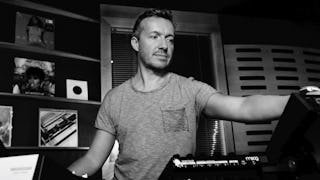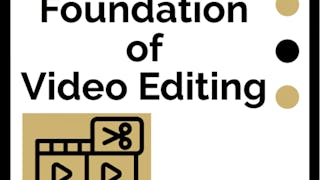Explore the sound that comes from the narrative world of film. Understand what film pioneers did to use images for sound in the silent era. Learn how the advent of sound technology transformed filmmaking and how some directors found innovative ways to use sound to bridge scenes, smooth out cuts and make the editing seamless and cohesive. Understand the difference between diegetic and non-diegetic sound, and subjective sound. Explore different types of sound cuts like the J and L cuts used widely in narrative film, news and documentaries, and especially in dialogue exchanges. Gain insights into the sound innovations by directors like Orson Wells, Alfred Hitchcock, John Ford and Robert Altman, and documentary filmmaker Ken Burns. Understand the use of music and sound effects, how to edit them, and when to use them. Engage in exercises where you can apply different types of sound transitions, and demonstrate your newfound knowledge through quizzes. All you need is basic editing software and some basic skills to use it. Presented by CU Boulder Journalism Instructor Paul Daugherty and CU Boulder College of Media, Communication and Information Media Technology Manager Emilie Johnson, Modern Sound Editing will take you on an exploration of the sound techniques that will help you keep your viewers immersed in your video creation.


您将学到什么
Describe how different sound elements enhance visual storytelling.
Identify sound elements such as dialogue, sound effects, and music, and analyze how they can be manipulated through editing techniques.
Recognize types of sound editing, including J- and L-Cuts, and demonstrate their use to achieve seamless transitions.
Explain how sound is used to establish mood and atmosphere in visual storytelling.
要了解的详细信息
了解顶级公司的员工如何掌握热门技能

积累特定领域的专业知识
- 向行业专家学习新概念
- 获得对主题或工具的基础理解
- 通过实践项目培养工作相关技能
- 获得可共享的职业证书

该课程共有3个模块
Welcome to this first module of Modern Sound Editing. In this module we’ll introduce you to the sound technology inventions that ushered in a new era of motion pictures, and new innovations in sound editing. But in this transitional period some silent film directors found ways to suggest sound with the visual, and they used more close-ups, allowing for subtle performances from actors. As sound technology improved filmmakers would begin to experiment with editing dialogue, which were covered by a variety of shots edited in ways that would strengthen the rhythm and pacing, and even to show the tensions within a scene. In your exercise, we’ll provide you with footage to try your own dialogue editing.
涵盖的内容
3个视频3篇阅读材料1个作业1次同伴评审
Welcome to the second module where we will introduce you to a couple of the most influential directors in film history, Orson Welles and Alfred Hitchcock. Their innovations in sound led to the modern era of filmmaking with techniques like the lightning mix, overlapping dialogue, sound bridges, and using J and L cuts to build suspense. In your exercises, we’ll provide you with footage to make your own J and L cuts, and you can also experiment with sound bridges.
涵盖的内容
4个视频3篇阅读材料1个作业2次同伴评审
In this third and final module, we’ll look at the techniques used by the Foley artist to re-create sound in a film. Learn about the use of music scores and how they can be used to cue a theme, character, a place, or even an action. For example, the shark theme in “Jaws” or the Imperial March composed for “Star Wars.” We’ll ask when to use music and why, and give some tips on how to edit to music. You’ll also learn about sound transitions, such as the “whoosh!” and the different ways you can transition from one scene to the next using sound. Experiment with what you learned using footage we’ll provide to edit sound transitions. Finally, we’ll explore how sound effects can be used to intensify photographs, evoking a sense of experience to an otherwise still image. With photographs and sound effects that we provide, try creating the sound environment or an old naval battle.
涵盖的内容
4个视频3篇阅读材料1个作业2次同伴评审
获得职业证书
将此证书添加到您的 LinkedIn 个人资料、简历或履历中。在社交媒体和绩效考核中分享。
从 Music and Art 浏览更多内容
 状态:免费试用
状态:免费试用University of Colorado Boulder
 状态:免费试用
状态:免费试用 状态:免费试用
状态:免费试用 状态:免费试用
状态:免费试用University of Colorado Boulder
人们为什么选择 Coursera 来帮助自己实现职业发展




常见问题
To access the course materials, assignments and to earn a Certificate, you will need to purchase the Certificate experience when you enroll in a course. You can try a Free Trial instead, or apply for Financial Aid. The course may offer 'Full Course, No Certificate' instead. This option lets you see all course materials, submit required assessments, and get a final grade. This also means that you will not be able to purchase a Certificate experience.
When you enroll in the course, you get access to all of the courses in the Specialization, and you earn a certificate when you complete the work. Your electronic Certificate will be added to your Accomplishments page - from there, you can print your Certificate or add it to your LinkedIn profile.
Yes. In select learning programs, you can apply for financial aid or a scholarship if you can’t afford the enrollment fee. If fin aid or scholarship is available for your learning program selection, you’ll find a link to apply on the description page.
更多问题
提供助学金,
¹ 本课程的部分作业采用 AI 评分。对于这些作业,将根据 Coursera 隐私声明使用您的数据。






